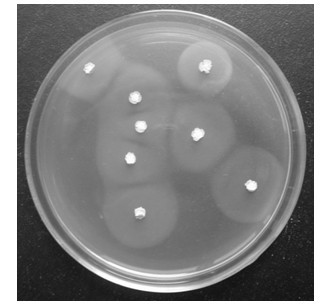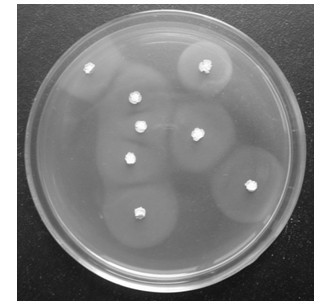Method for screening epsilon-polylysine producing strains
A technology for producing polylysine and bacteria, which is applied in biochemical equipment and methods, microbe measurement/inspection, chemical recovery, etc., can solve the problems of toxicity of target strains, complicated screening methods, heavy workload, etc., and achieve reduction Effects of screening cost, shortening screening cycle, and reducing workload
- Summary
- Abstract
- Description
- Claims
- Application Information
AI Technical Summary
Problems solved by technology
Method used
Image
Examples
Embodiment
[0030] Take 1 g of soil samples air-dried for 3 days, add 9 mL of sterile distilled water, shake fully in the test tube, and let stand for 1 h. Then the soil suspension was serially diluted, and a certain dilution was applied to the primary screening medium containing 50 mg / L potassium dichromate, and cultured at 30°C. After 5 days of culture, since the positively charged polymer secreted by the microorganisms can produce a transparent circle on the agar medium, the microorganisms that produce positively charged substances can be sensitively distinguished based on this phenomenon. Pick 40 single colonies producing hyaline circles to the slant medium and culture them for 5 days.
[0031] Drop an appropriate amount of Dragendorff reagent onto the surface of the primary screening medium containing strains producing hyaline circles to cover the surface of the plate, and observe the color change around the strains after standing for 30 minutes. It is found that 24 strains producing...
PUM
 Login to View More
Login to View More Abstract
Description
Claims
Application Information
 Login to View More
Login to View More - R&D
- Intellectual Property
- Life Sciences
- Materials
- Tech Scout
- Unparalleled Data Quality
- Higher Quality Content
- 60% Fewer Hallucinations
Browse by: Latest US Patents, China's latest patents, Technical Efficacy Thesaurus, Application Domain, Technology Topic, Popular Technical Reports.
© 2025 PatSnap. All rights reserved.Legal|Privacy policy|Modern Slavery Act Transparency Statement|Sitemap|About US| Contact US: help@patsnap.com



